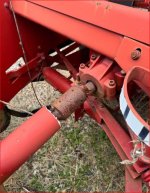Bentrim
Gold Member
- Joined
- Apr 22, 2020
- Messages
- 352
- Location
- York County, Pennsylvania
- Tractor
- Massey Ferguson 245, Massey Ferguson 14 Allis Chalmers G
The drawbar length is crucial for proper PTO shaft engagement and operation. A 1000 RPM PTO system is typically found on more modern and higher horsepower tractors and is designed to handle heavier implements. The 16-inch measurement is a standard for 1000 RPM PTOs and ensures the PTO shaft can properly telescope and retract as the implement moves over varying terrain. This is especially important when using a three-joint driveline on a drag implement, where the tipping bearing should be close to vertical on level ground with the correct drawbar length.
Anybody remember the special hitch JD used on the balers? Special adjustable casting the slipped over the drawbar and extended it to about 1/2 the length of the PTO shaft.
Anybody remember the special hitch JD used on the balers? Special adjustable casting the slipped over the drawbar and extended it to about 1/2 the length of the PTO shaft.



